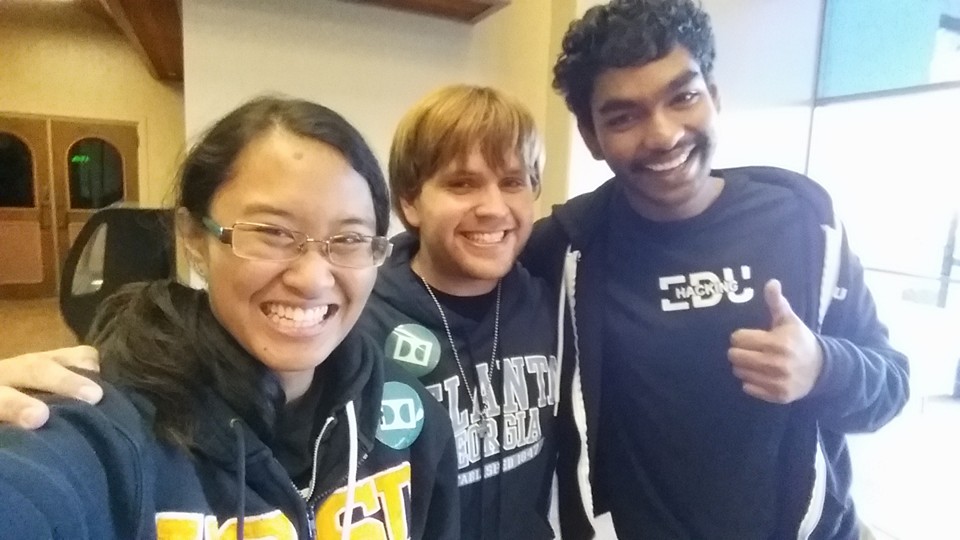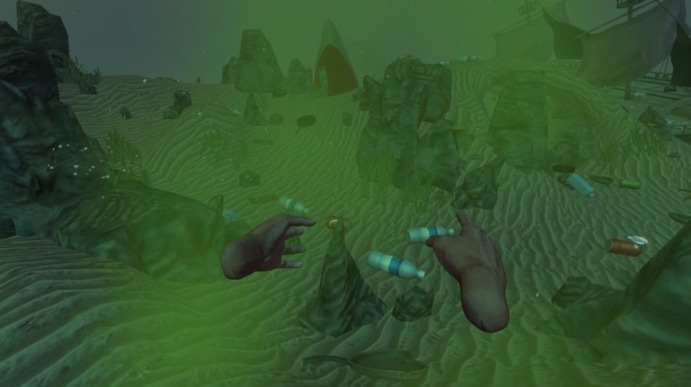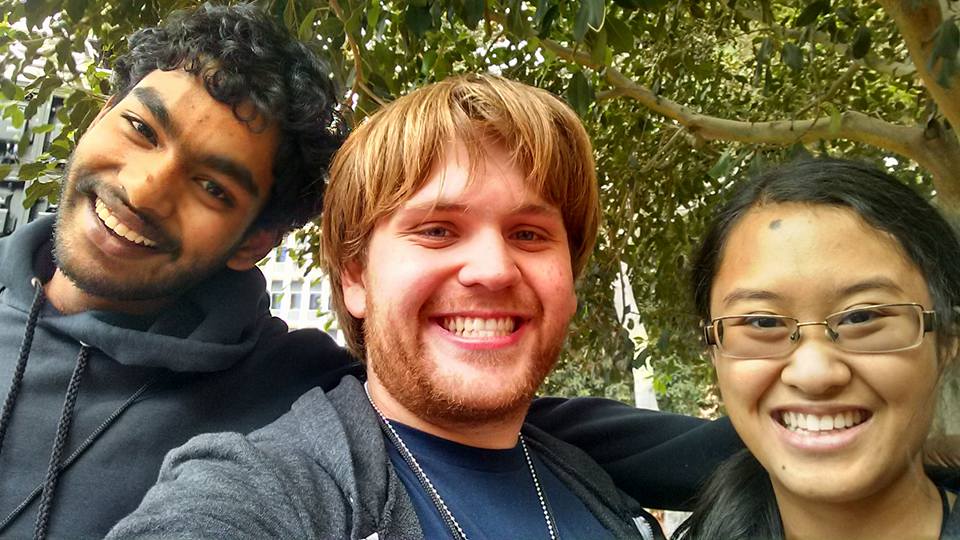Hacking for Good: Entering the World of Socially Conscious Virtual Reality
San Diego, Calif., Jan. 27, 2016 — When one imagines a high school biology lesson, certain learning processes come to mind: lectures, slideshows, whiteboards and markers, small lab experiments. Probably not among them: watching organelles and molecules float past in a human cell, reaching out to them with your bare hands and seeing what they produce when brought together.

This is the “hands-on” approach to biology seen in Cell VR, a virtual reality experience developed by University of California, San Diego undergraduates Kristin Agcaoili, Anish Kannan and Connor Smith. Created at HackingEDU, a 36-hour education-themed hacking competition (or “hackathon”) in San Mateo, Calif., Cell VR offers a radically new approach to high school-level biology: immersing its user inside a human cell.
“We used hand mechanisms so that you could reach out into the cell and grab the different parts,” said Smith. “For example, if you knew that glucose combined with a mitochondrion to make ATP, you could literally grab a glucose, grab a mitochondrion, put them together in your hand—and they would make ATP.”
Although , virtual reality is a burgeoning field, VR headsets such as the Oculus Rift remain largely unavailable to the public, and VR’s practical applications — including educational applications — remain largely unexplored. Cell VR sets out to change that, encapsulating a new philosophy toward all that the field has to offer: in Smith’s words, “using virtual reality for good.”
“We were really proud of that project because we felt like it had a greater impact,” said Smith. “We wanted to spread a passion for VR, but also for education, because we believe that virtual reality can be used for things other than just games. And education’s a field that can be so well-developed.”
For Agcaoili, Kannan and Smith, who are sophomores majoring in Computer Science and Engineering (CSE), these sorts of inventive, socially conscious virtual reality hacks are regular occurrences. In the past year, they have traveled to hackathons in cities up and down the Western states, from Berkeley to Tucson, and even as far afield as Atlanta, Ga., where they represented UC San Diego in Georgia Tech’s HackGT hackathon. Their projects’ subject matter is equally far-ranging: in addition to Cell VR, they have built an environmental awareness experience, a narrative-driven game, a virtual workspace and a “health hack,” which uses soothing landscapes to reduce stress and lower heart rates.

Their reception has been enthusiastic. At HackingEDU, where more than 1,000 students comprising 100 teams competed to develop digital education tools, Cell VR took third place. A few weeks later, Diver, their environmental awareness project, was named the best game and VR hack at HackSC 2015, a hackathon hosted by the University of Southern California. Designed to bring attention to marine pollution, it tasks its user with swimming around an ocean and picking up trash: bottles, cans, even frying pans.
“As you do so, the water becomes less murky; it gets clearer,” said Smith. “It sends a message about pollution in the ocean — one that you can visually see.”
The team’s accomplishments at HackingEDU and HackSC marked both the beginning of further success and a return to their roots. It was at HackSC 2014 that Smith first began working with virtual reality, a step that later led to his collaborations with Agcaoili and Kannan. After creating a virtual reality game for the Oculus Rift headse t—“my first virtual reality experience,” according to Smith — he made the acquaintance of a USC student named Jake Green, who hoped to develop education-related virtual reality experiences. (Green is now the C.E.O. of the Los Angeles-based virtual reality company Zypre.) Eager to forge connections with potential collaborators at UC San Diego, he enlisted Smith’s help. Smith, in turn, brought on board five of his friends, including Agcaoili and Kannan.
“After that, we very much kept interest in the idea of doing something educational,” said Smith.
In their new projects, Agcaoili, Kannan and Smith aim both to engage this interest and to foster it in others. Virtual reality experiences like Cell VR, they note, have tremendous potential to impact high school students in particular, who are at what Smith called a “deterministic age” for their educational future.
“That’s a really important age to get people inspired, and get them interested in education—which is what we’re trying to achieve through virtual reality, of course: interest and passion for education and for learning,” he said. “We think that’s the age where the difference can really be made.”

HackingEDU’s support and sponsorship, they said, have been instrumental in helping them achieve this. In addition to helping Agcaoili, Kannan and Smith obtain publicity for Cell VR, the organization is working to implement the program in high school classrooms; they’ve also sent the team a range of high-powered, not-yet-commercially-available virtual reality equipment, including an Oculus Rift headset (tentatively slated for a public release date of March 2016).
Closer to home, further development of Cell VR and other virtual reality experiences is ongoing, with contributions from one of Agcaoili, Kannan and Smith’s other undertakings: UC San Diego’s recently established Virtual Reality Club, in which all three are officers. One of the university’s fastest-growing groups, Virtual Reality Club operates as an informal teaching program, hosting weekly workshops for virtual reality novices and experienced developers alike, and as a professional organization, connecting students to companies and internship programs. Much of their work is collaborative; Kannan noted that he, Agcaoili and Smith are sharing some of their prior virtual reality projects with the group “so anyone can try to fork off of them, improve them, do what they want with them.” The club also serves as a node in a network of similar groups at other colleges and universities, which they eventually hope to bring together for a UC San Diego-hosted virtual reality hackathon.
With so few virtual reality headsets readily available for use, the Virtual Reality Club has faced a very real stumbling block: how to teach the fundamentals of virtual reality to an ever-growing group of interested students when the necessary equipment is so difficult to obtain. When the Oculus Rift is released, they said, the club will receive 40 headsets; without them, however, the club’s activity is limited. Here, too, Agcaoili, Kannan and Smith’s successes at Hacking EDU and HackSC have had a substantial impact. Following the hackathons, CSE lecturer Rick Ord connected the students with Google, who then sent the club 100 of their Google Cardboards—foldable cardboard virtual reality viewers designed to be used with smartphones. Receiving the Cardboards, they said, was “huge.”
“In general, the Google Cardboards are for the members of the club to do what they want, and to really experiment and grow as individuals,” said Smith. “Right now, virtual reality is such an undeveloped field that of course nobody has experience with it. We were very lucky to have this opportunity to work with these people in L.A. and to get the Oculus Rift. Most people aren’t going to have that. They haven’t even had the chance to get their hands on a working headset, or to develop for it. We really wanted to actually get the materials that they could use to do that.”
They also will enable further collaboration within the club’s ranks: “We’re also thinking about importing Cell VR to the Cardboard so that more people could access it,” said Kannan.
Even with all that lies ahead for their prize-winning projects and their growing club, Agcaoili, Kannan and Smith remain focused on learning: on helping others learn, and on continuing to learn themselves.
“I think if I’m imparting any words of wisdom,” said Smith, “it’s that to go to these hackathons, you don’t need experience; you don’t need to be extremely good at something…. It just matters that you try to learn something, that you try to achieve something, and that you’re passionate about that. You try to do something you care about.” Doing so, he said, will always produce dividends.
“Virtual reality was always something we did on the side, because it was never applicable anywhere. And now it’s applicable everywhere.”
Related Links
Media Contacts
Tiffany Fox
(858) 246-0353
tfox@ucsd.edu
